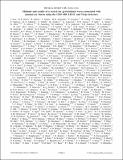Methods and results of a search for gravitational waves associated with gamma-ray bursts using the GEO 600, LIGO, and Virgo detectors
Author(s)
Aggarwal, Nancy; Barsotti, Lisa; Biscans, Sebastien; Buikema, Aaron; Essick, Reed Clasey; Isogai, Tomoki; Katsavounidis, Erotokritos; Lee, P. J.; Matichard, Fabrice; Mavalvala, Nergis; Miller, John; Oelker, Eric Glenn; Vitale, Salvatore; Weiss, Rainer; Yam, William; Zhang, Fan; MacInnis, Myron E; Shoemaker, David H; Wipf, Christopher C.; Donovan, Frederick J; Gras, Slawomir; Libson, Adam A.; Sankar, Shannon Reynier; Zucker, Michael E; Fritschel, Peter K; Bodiya, Timothy P.; Evans, Matthew J; Mason, Kenneth R; Mittleman, Richard K; Vaulin, Ruslan; ... Show more Show less
DownloadAasi-2014-Methods and results of.pdf (1.371Mb)
PUBLISHER_POLICY
Publisher Policy
Article is made available in accordance with the publisher's policy and may be subject to US copyright law. Please refer to the publisher's site for terms of use.
Terms of use
Metadata
Show full item recordAbstract
In this paper we report on a search for short-duration gravitational wave bursts in the frequency range 64 Hz–1792 Hz associated with gamma-ray bursts (GRBs), using data from GEO 600 and one of the LIGO or Virgo detectors. We introduce the method of a linear search grid to analyze GRB events with large sky localization uncertainties, for example the localizations provided by the Fermi Gamma-ray Burst Monitor (GBM). Coherent searches for gravitational waves (GWs) can be computationally intensive when the GRB sky position is not well localized, due to the corrections required for the difference in arrival time between detectors. Using a linear search grid we are able to reduce the computational cost of the analysis by a factor of O(10) for GBM events. Furthermore, we demonstrate that our analysis pipeline can improve upon the sky localization of GRBs detected by the GBM, if a high-frequency GW signal is observed in coincidence. We use the method of the linear grid in a search for GWs associated with 129 GRBs observed satellite-based gamma-ray experiments between 2006 and 2011. The GRBs in our sample had not been previously analyzed for GW counterparts. A fraction of our GRB events are analyzed using data from GEO 600 while the detector was using squeezed-light states to improve its sensitivity; this is the first search for GWs using data from a squeezed-light interferometric observatory. We find no evidence for GW signals, either with any individual GRB in this sample or with the population as a whole. For each GRB we place lower bounds on the distance to the progenitor, under an assumption of a fixed GW emission energy of 10−2M⊙c2, with a median exclusion distance of 0.8 Mpc for emission at 500 Hz and 0.3 Mpc at 1 kHz. The reduced computational cost associated with a linear search grid will enable rapid searches for GWs associated with Fermi GBM events once the advanced LIGO and Virgo detectors begin operation.
Date issued
2014-06Department
Massachusetts Institute of Technology. Department of Physics; MIT Kavli Institute for Astrophysics and Space ResearchJournal
Physical Review D
Publisher
American Physical Society
Citation
Aasi, J., B. P. Abbott, R. Abbott, T. Abbott, M. R. Abernathy, F. Acernese, K. Ackley, et al. “Methods and Results of a Search for Gravitational Waves Associated with Gamma-Ray Bursts Using the GEO 600, LIGO, and Virgo Detectors.” Phys. Rev. D 89, no. 12 (June 2014).
Version: Final published version
ISSN
1550-7998
1550-2368